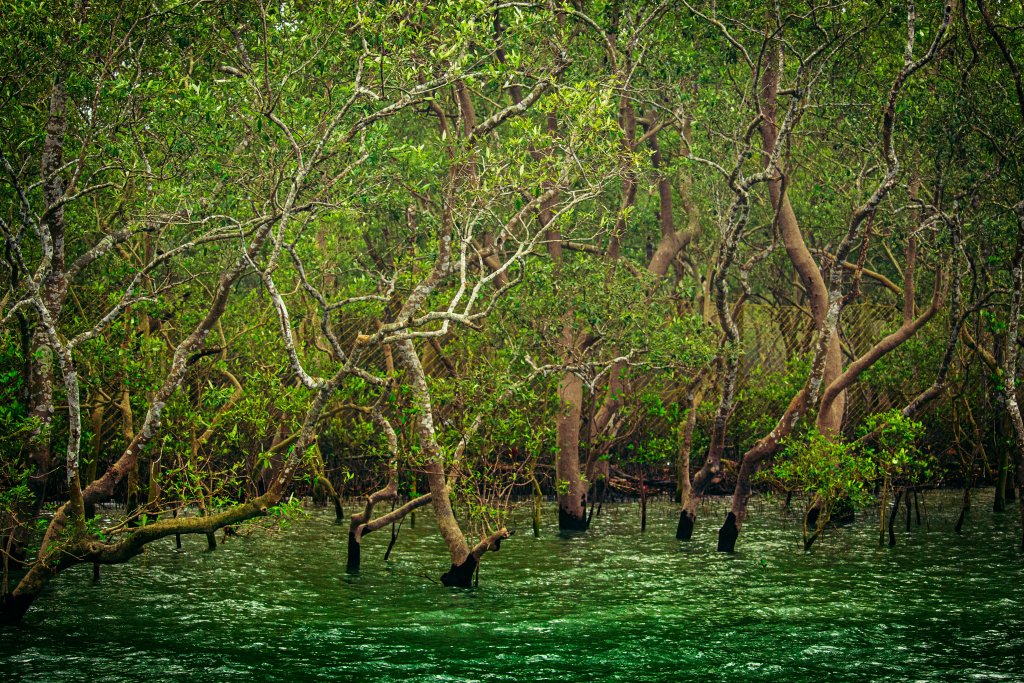The story ‘Mangrove Maj’ combines the potential of mangrove forests as sea wall protection and the huge potential of biochar for carbon capture. Mangrove forests can protect coastal communities from all sorts of natural disasters such as forest fires, storms and cyclones, the WWF has a very extensive page that describes this solution.
The fact is that mangroves will naturally grow in the right habitats for them, so perhaps the best solution of all is to stop cutting down mangroves forests where they already exist.
This page is dedicated to information and research on using mangrove forests as sea walls. Please see the biochar page for information on that solution. At the bottom of the page, you will find a table which features calls to action for policymakers, funding bodies, businesses and the public.
According to the US National Ocean Service, mangroves are “a group of trees and shrubs that live in the coastal intertidal zone”.
This solution is classed as low-hanging fruit (low risk, quick win). Mangrove terraces are likely to be relatively simple to try. Several sites will need to be developed to establish the pros and cons of different approaches.

Solutions such as this one already exist (see Seawater Solutions). This video by the iSelectFund explains how this solution would work:
Natural regeneration and propagation of mangroves through seeds and seedlings Mangroves grow in a modest temperature of not more than 35°C and low salinity water, making their survival a big challenge in Abu Dhabi, where temperatures rise during summer months. Temperature and salinity may be an issue in some of these harsher areas but there are other areas we could consider such as Pulau Mesa (Indonesia).
This example from Bangladesh is also insightful.
How does the solution rate in terms of…
| Climate impact (tonnes of carbon removed/saved) | Each site could have the potential to deliver 10’s of thousands of tonnes of CO2 sequestration per year, through biochar, new plant growth and soil improvement. |
| Climate adaptation/resilience | Large areas of inhospitable coastline could be converted into green landscapes, using salt water tolerant plants and mangroves. This would transpire water which would form more clouds and ultimately more rainfall. |
| Social justice i.e., addresses inequalities, diversity, inclusion (high impact) | The process is well suited to some of the poorest parts of the world, Yemen, and other poor coastal areas of the middle east. |
| Cost of actions needed to progress goal | Mangrove terraces would be a very low-cost project, using basic agricultural techniques, along with a small solar panel and a submerged pump. The system would be relatively easy to monitor and assess in terms of carbon/biomass outputs with satellite systems. |
| Which location(s) is solution most needed/applicable | Any area of arid coast, on seas or lakes, could be suitable for this system. The system could also be used in arid areas where saline groundwater is available, even where fresh groundwater is not an option. |
| Risk | This is a very low-risk option. It will quickly become apparent in the first experiments if the use of seawater is harmful to the landscape. |
| Feasibility | This system could be deployed today. |
What other plants grow amongst mangroves?
Watch this video about “Regreening the Sinai” or read the article in the Guardian on the same topic. There are also some quite small coastal watersheds here (in North and Middle Eastern Egypt) that could be switched to salt water with limited impact on neighbouring watersheds.
Other uses of mangroves
The coppicing grows beautiful straight poles. Most of them are used for temporary structures. As the number of climate refugees has grown, so has the number of encampments which use huge quantities of materials. The poles are used for tents and canvas structures of various sizes, and as they are wood, they are easy to work with and still reassuringly natural. To avoid them being used for firewood, to prevent rot, mould or insects, and to extend their life, they are pressure treated with Borax, like this bamboo school in Bali. Because the poles last for years, it is recognised as a form of carbon sequestration with massive added social benefits. This generates further income with new so-called social credits as well as carbon credits.
Interested in progressing this solution further?
Here are a series of steps you can take to progress this climate solution further. You can also contact us at greenstories@soton.ac.uk and we’d be happy to connect you with experts in these solutions to discuss further.
| Actions for policymakers | Deny planning permission for developments that cut down existing mangrove forests. Provide accessible permits for limited projects operating at the 1,000 TPY scale – the potential for harm is small, no more than 3 articulated lorries. |
| Actions for funding bodies | Provide full funding for dozens of projects in multiple locations around the world. |
| Actions for business | Develop carbon credits which support and facilitate the deployment of every aspect of the process, including for highly speculative projects which may fail. Do not put forward developments that involve cutting down existing mangrove forests. |
| Actions for public | Volunteer to build these sites and sponsor long-term. Try new crops from this source. Campaign against developments that involve chopping down existing mangrove forests. Find your government representative or Member of Parliament and email them, whether you are in Australia; Canada; UK; USA or elsewhere. Join campaigns such as about Surfers Against Sewage | Environmental charity tackling plastic pollution (sas.org.uk). |
